The soil covers one’s eyes and nostrils, gets stuck to sweaty skin, makes its way inside shoes and clothes, settles onto the camera lens in a small layer. It is difficult to breathe: not just because of the heat and heavy armoured vest, but also from dust engulfing everything. Sometimes, it seems as if it enters one’s lungs. A few colleagues and myself lie under the truck of the sappers – this is the very truck that was used to transport unexploded shells. Today, there are a lot of them – equivalent to about 250 kg of TNT. As we set up the cameras, we can hear that the sappers are getting ready for a controlled explosion: they check whether the locals have been warned about the potential explosions, whether anyone has entered their perimeter and if the detonator is in order.
– Perimeter?
– Ready!
– Detonator?
– Ready!
– Group?
– Ready!
– Detonation!!!
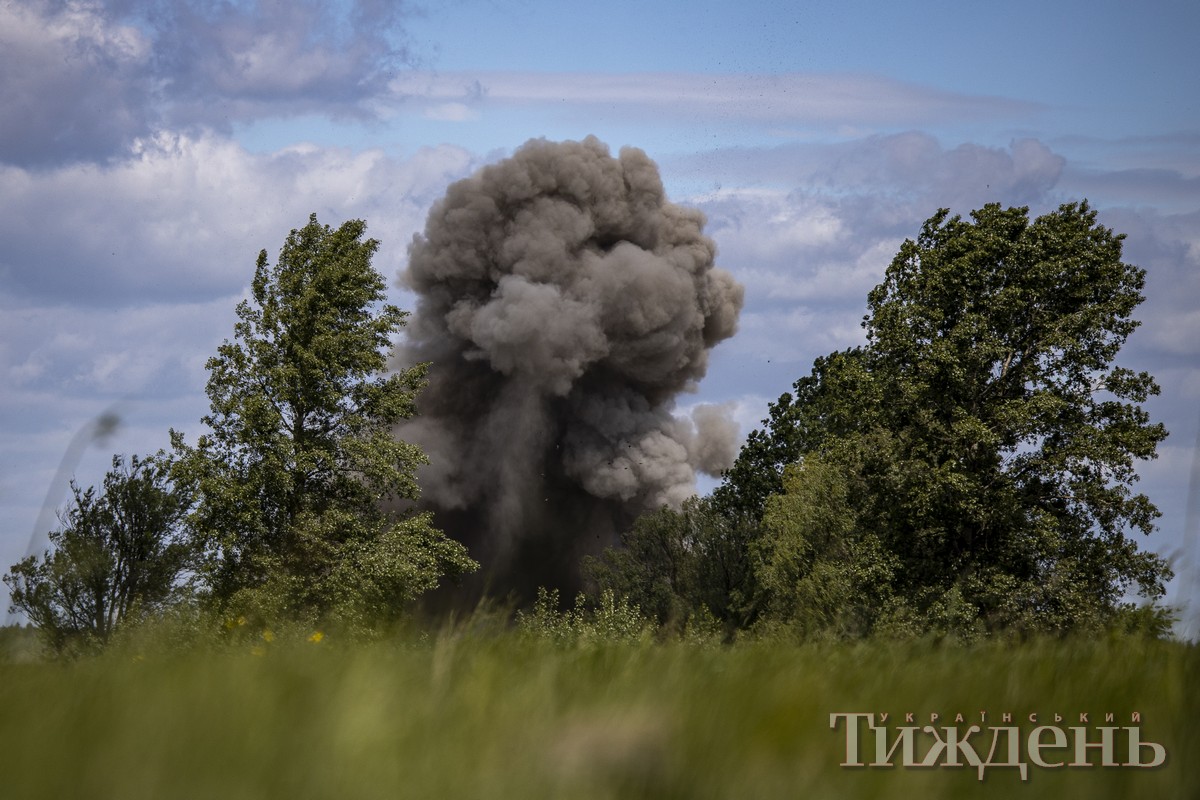
Photos by Stas Kozlyuk
Stolen shoes
Borodyanka. A small town, 40 minutes drive from Kyiv. Before the Russian invasion, there were about 13 thousand inhabitants here. In March, the town was under direct assault by the Russian army, as it was bombarded with high-explosive shells and hit by rocket artillery from Smerch and Uragan rocket systems. According to the head of the Kyiv Regional Military Administration, the town had 21 out of 29 high-rises damaged, 8 completely destroyed. Local residents who have lived through the bombardment and occupation say that the Russians did not allow the locals to clean out the rubble or extract people who were alive and trapped under it. As for daily life under occupation, not much has been said by the locals. Mostly, they say it was simply ‘difficult’.
In April, the Russian army retreated, leaving only ruins behind. The streets were covered with undetonated shells and broken glass. There was no electricity, gas or water. The locals resorted to open-fire cooking out on the streets. This was the picture seen by the sappers of the State Emergency Service of Ukraine upon arrival to work in Borodyanka.
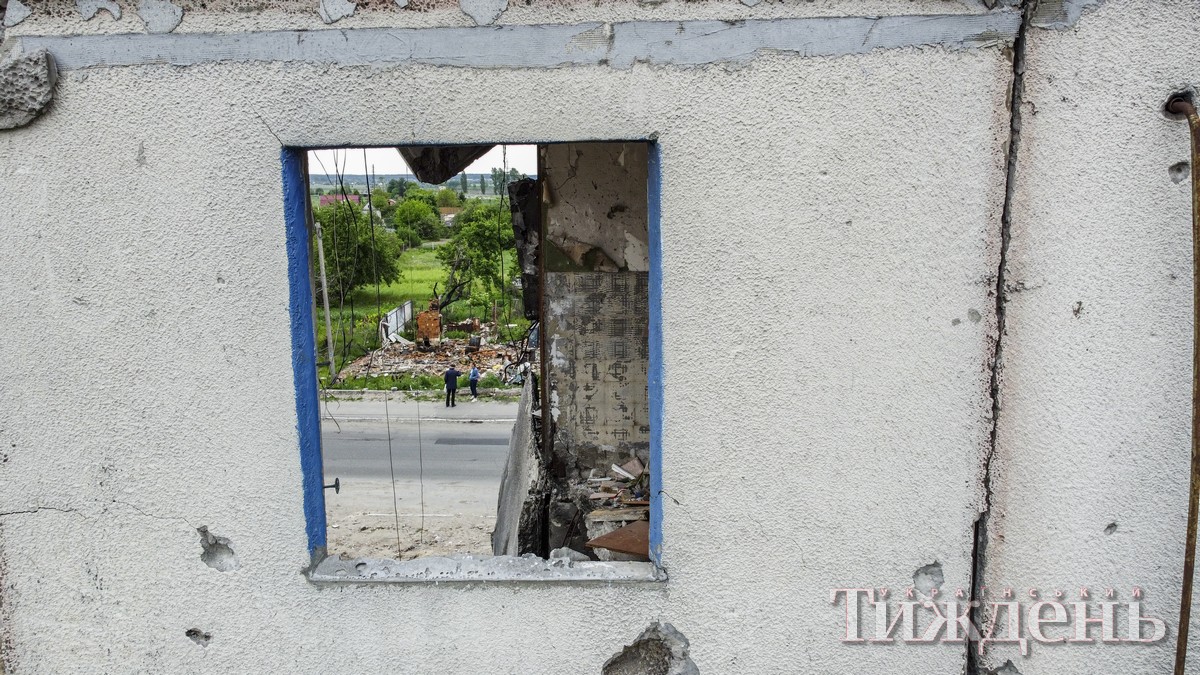
– When we arrived – the streets were filled with unexploded shells, including cluster munitions. Circumstances forced us to detonate them on the spot. We dug holes in the ground where we then placed the yet-to-be detonated shells in order to clear the streets for service vehicles – says Oleksandr Pinchak, the head of the group of sappers involved in the operation.
He recalls a great load of work for the workers. Oleksandr’s group, which consisted of five people, is responsible for an entire regional territory – the region of Borodyanka. Between breaks, several groups from western Ukraine helped: from the towns of Drohobych, Rivne and Ivano-Frankivsk. After a few weeks, they were deployed further up north in the Kyiv region.
We become acquainted with them in the front yard of a high-rise, next to a series of private garages. Inside, work is already in progress by Oleksandr’s subordinates: they probe the piles of garbage left by the Russians and shed light with flashlights in the basements. Next to the entrance are a few belongings of the invaders: overdue military rations with a five-pointed star displayed on the packaging and canned lard. As soon as the sappers retrieved it, they burst out laughing.
‘Oh, look at what the Russians stocked up here’ – laughing they point onto belongings of Russian soldiers to the owners of the garage, a man and woman aged about 50.
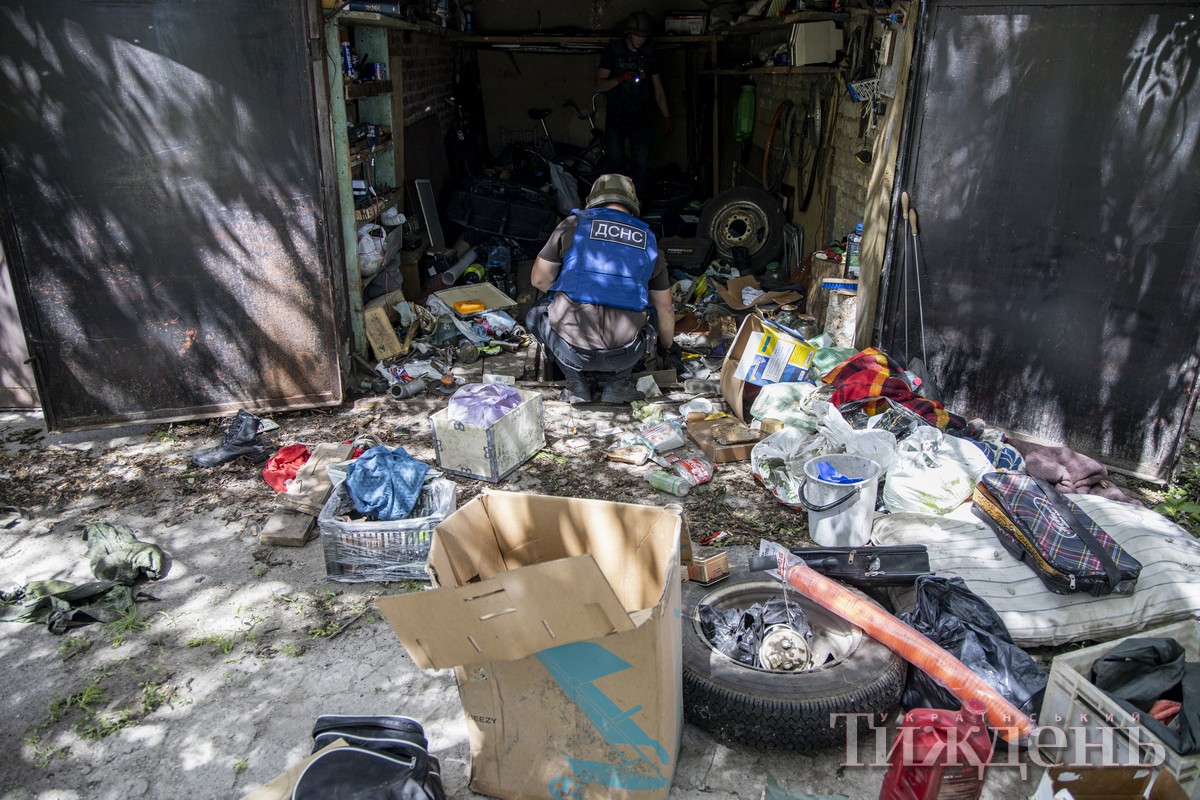
The two stand nearby, observing the sappers working. They also are unwilling to name themselves, as they are scared. They say that once they have returned to Borodyanka, they came down to their garage. Upon seeing the doors broken through, they decided to call the state emergency services so that they could find any ‘surprises’ left by the invaders.
‘Of course, it is scary. Because, maybe, there are grenades there. Or explosive devices set up as traps. We were not in the city when it was occupied, we left as soon as the war began. We closed the garage. And only recently, we have returned. We can see that the Russians lived in our garage as the lock is broken and there is a lot of trash inside. I know that they had a base nearby at a child centre. We can see that they decided to stock in here – some of the things stored here are not ours. Perhaps, they brought some of these from nearby apartments or neighbouring garages, or wherever they stole them from’ – say the couple.
Other people’s belongings – are the already mentioned can of lard, licence to carry firearms issued to the couple’s neighbour, and mysterious Polish number plates on the car. Boots as well. As soon as the owners of the garage see them, they seem puzzled.
– This is not ours for sure. Not the neighbours’. Where is this from? – they ask the sappers.
– This must be from the store on the central street, the shoe store was plundered – explains Oleksandr.
The boots are then thrown onto the pile of garbage left by the Russians, found in the basement of the garage. There are no explosives or traps here, thankfully. The owners can then tranquilly enter and start the cleaning process. And we amust go to a new area of risk – dachas near the town.
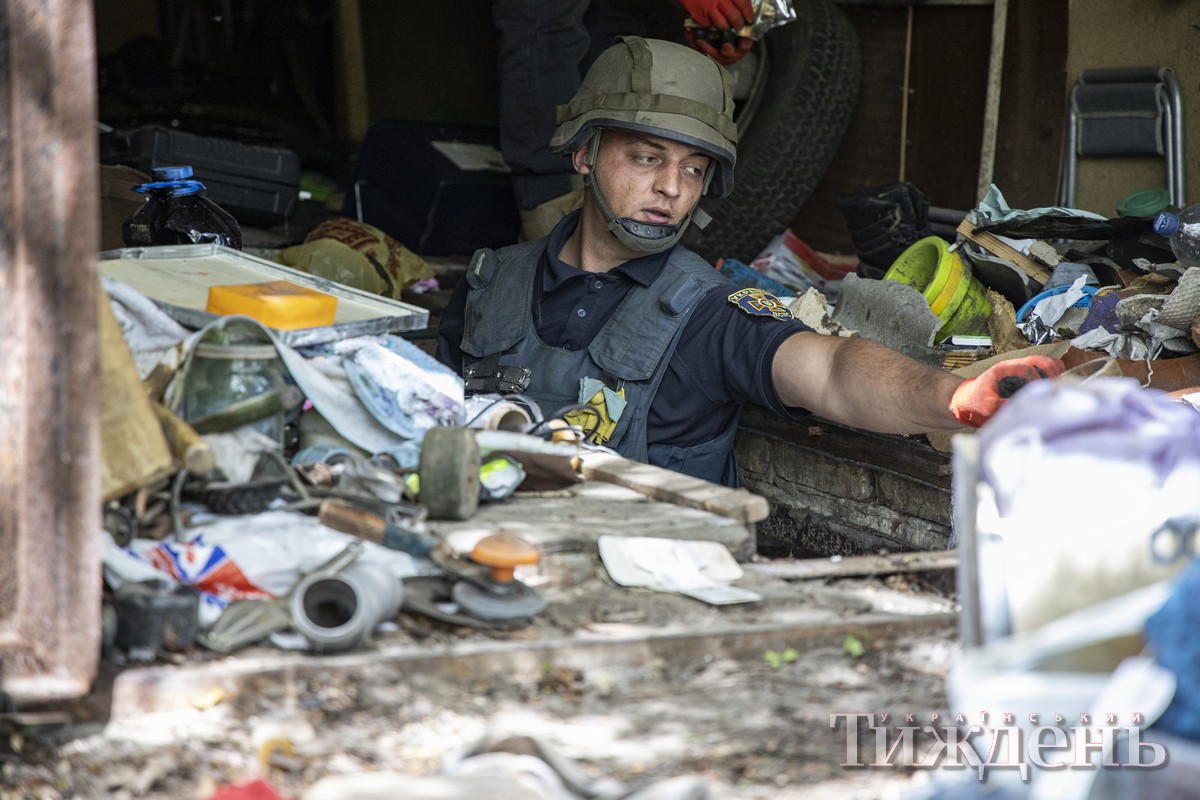
Stolen alcohol
– Our headquarters are based in Bila Tserkva. Before the 24th of February, we lived according to the plan made for 2022: we were supposed to demine the Kyiv region. Don’t be surprised here, after the Second World War, a lot of unexploded shells rest there. We searched for them mostly in places where there were trenches and clashes. In addition, we were supposed to go on a working trip to Donbas and continue the demining there – says Oleksandr, as we continue our drive.
The sappers’ plans collapsed on the 24th of February. Since then, they sleep at work while going home is merely for a change of clothes and a hot shower.
As we drive by a destroyed bridge and turn into a field, we follow a dirt road between the cottages of Borodyanka residents. The sappers continue their story: from the beginning of the Russian invasion, they took care of operative demining. After all, all the shells and explosives landing in the Kyiv region was under their jurisdiction of work. For example, one time, they needed to extract ammunition from a shot-up truck. As soon as the team of sappers finished, Russian mortar shells came flying in on them.
– Different things had to be taken: rockets, bombs, mortar shells. For the most part, we had to take out parts of the Iskander warhead as it weighs 410kg, with the aid of ‘small mechanisation’, says Oleksandr, laughingly, – we loaded it in the truck and then shipped it out. What is ‘Small mechanisation’ you ask? Well, for the shipping of the Iskander rocket parts, we needed eight people, eight pairs of hands. We loaded it manually.

We then continue to drive past forests and fields. The blossoming of flowers is coming to an end here. The air smells like hot soil and sometimes like dead grass, which gets stuck to the wheels of our car. Eventually, after driving through overgrown and plant-covered dirt roads, we reach the cottages.
– We haven’t come across mined refrigerators yet, nor mined dead bodies. For example, when we went through liberated Bucha and Irpin, we checked around one hundred bodies. No mines. Such cases however have been found by our colleagues, from other departments. I can confirm this – continues Oleksandr.
We exit the car next to a two-story wooden house. In the yard, a middle-aged man is seen standing. He introduces himself as Anton. He says that as soon as the Russian invasion was underway, he and his family left for the Chernihiv region. That is where he experienced occupation. When the Russians left, he decided to come back to Borodyanka and check on his mother-in-law. He instantly realised that the household was used as a shelter by the invaders. They left the house in pure chaos: men’s and women’s clothing lies all over the floor, food from the kitchen has been stolen, furniture turned over, while linings from the second floor have been stolen. It is unknown what the Russians were looking for here.
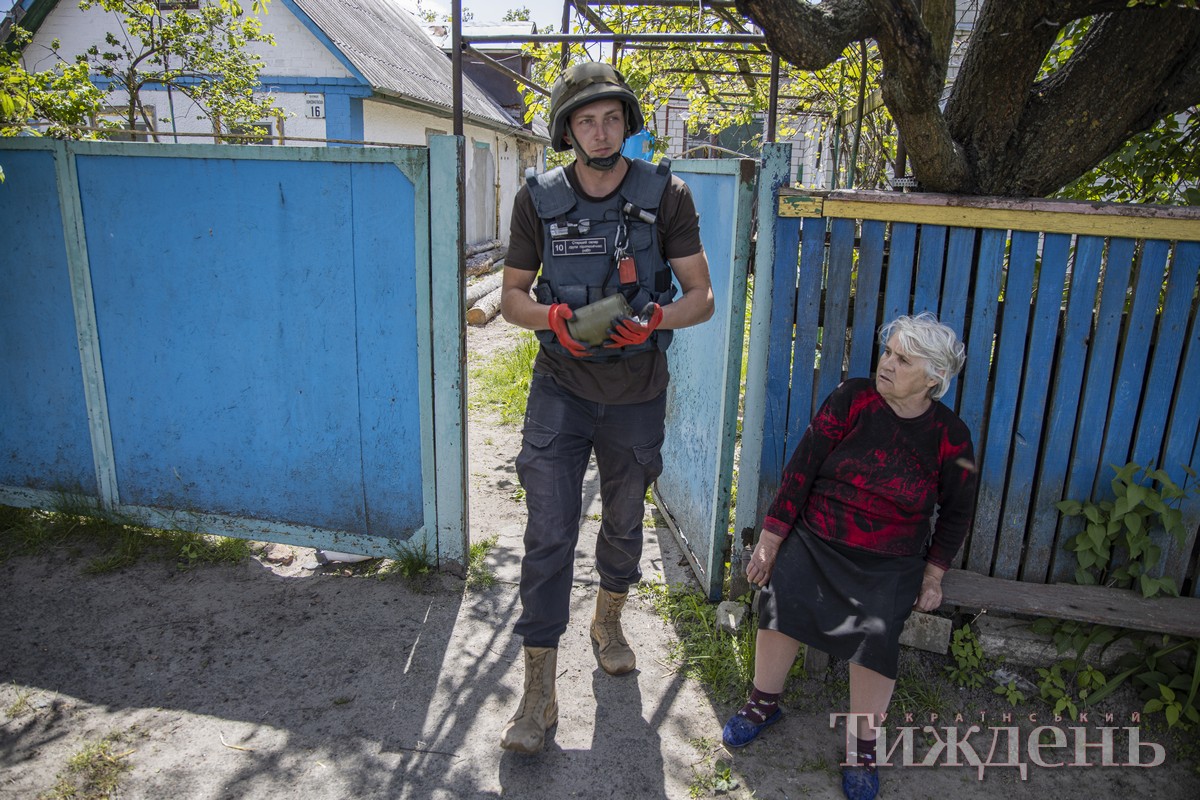
‘The neighbours said that the Russians did not particularly commit atrocities in the village, did not torture or execute anyone. However, the houses were robbed. When I came, my entire house was covered with bottles. These were my reserves from my cellar. They just took everything out and drank it. The neighbour said that they spent four days drinking here. They dragged everything back to their trenches: food products, clothes and even firewood’ – Anton tells us.
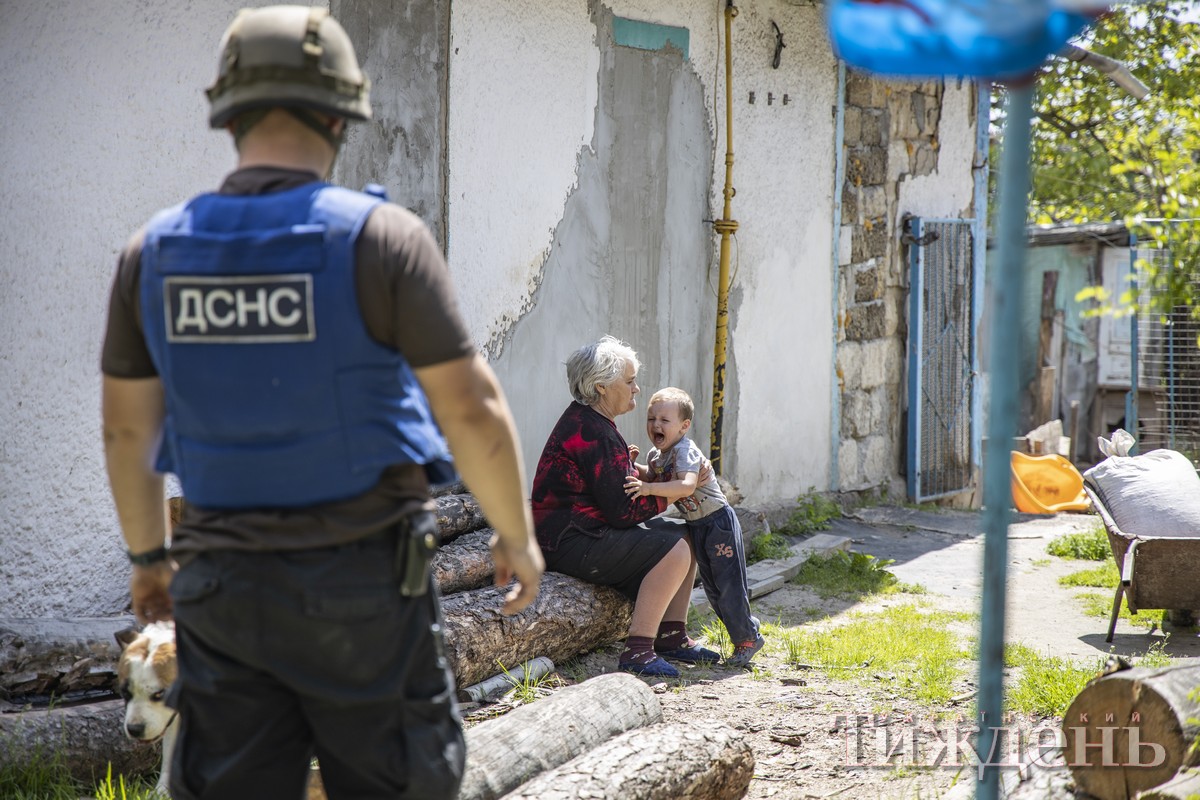
As we speak, one of the sappers walks around the house with a probe, covering its perimeter, checking all of the surrounding paths that lead to the small wooden gazebo here. In the basement – another explosive technician is at work. He is checking all of the dark corners of the cellar for suspicious boxes. The third sapper is working at the top (floor) of the house. He probes the surface of clothes left lying around by the Russians, including women’s underwear, bras, men’s trousers and socks.
– They even turned the flour inside out in the hose. Probably looking for gold and diamonds, – the sappers say amusingly
– They took food from the kitchen, different types of cereal. They shipped all kinds of canned foods out of the cellar, the neighbour saw as they rolled it out on a wheelbarrow. My mother-in-law’s bras were left lying around all over the floor. I don’t know, perhaps the Russians were trying them on and they weren’t the right fit? – sarcastically says Anton.
After an hour of probing and checking for explosives, the emergency service specialists do not find a single shell of ammunition. They then thank Anton for his call and attentiveness and proceed to get back in their cars. We proceed to drive to the village of Nova Hreblya, a few kilometres from Borodyanka. One of the families has recently returned after being evacuated and decided to call the sappers.

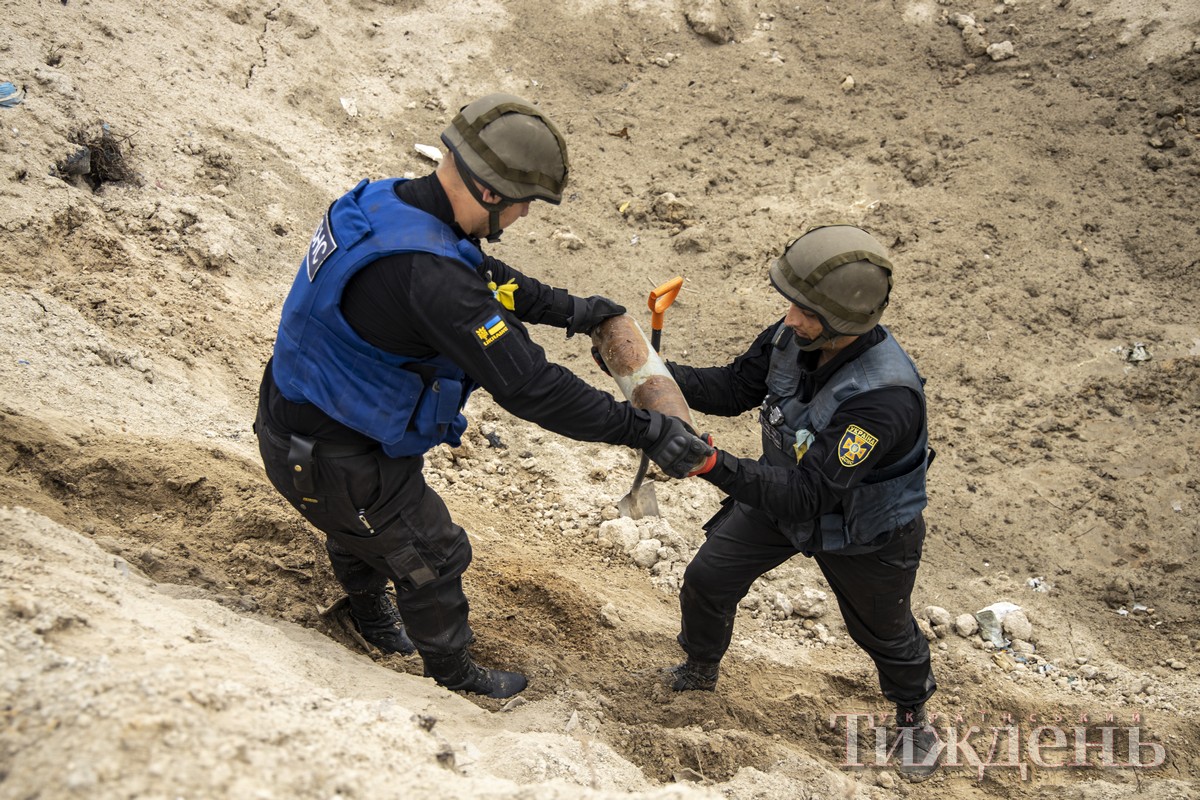
A ‘frog’ in the kitchen
We drive, jumping through bumps on a devastated asphalt road through villages near Borodyanka: ahead of us is the sapper car followed by a truck with unexploded ammunition and then finally us. Here and there, one can see signs of Russians’ once presence: the roadside is filled with burnt cars with ‘V’ markings, while also showing a burnt house and remainders of what once were walls. The locals which have returned home, attempt to bring back their homes to their formal state: some replace windows, fences, others cover up holes made in their roof.
We proceed to approach a house, surrounded by a blue fence. A girl carrying a child in her hands greets us. She says that yesterday she came back home and found a strange object in their summer kitchen. Behind her back, out in the yard, an old lady is seen sitting, and beside her, a young boy wiggles around. As soon as she sees unknown people in bulletproof vests, she starts crying and hugs the young woman. Quietly, we walk past.
– It’s good that it sits here unactivated, – yells Oleksandr from the kitchen, – we’re going to take this thing and then you can walk here in peace.
We follow the sappers to a small room. At first glance, there is nothing dangerous: just old pots and a teapot. Perhaps, the stove, where food is prepared, one can see a strange green keg. The sappers carefully take it out to load it into the truck.
– This is a souvenir that was left for us. Our village was occupied, –says Halyna, while letting go of her grandson, – compared with other villages, it was relatively quiet here. The Russians came with their armoured vehicles and drove around on them. It was even possible to leave the village at first.
Meanwhile, two children run around the yard. Two dogs also playfully run around us. Halyna continues her story.
– One day, I look out of the house into the window and I see a Russian climbing over the fence towards me. I go outside and say: ‘If you knocked, I would open, why are you doing it this way’. He then asked who was in the house. I said: only my grandfather. Old, deaf and blind. Nevertheless, they proceeded to enter the house. They said that they are looking for soldiers, men. After looking through, they went to the next house to do more of the same. I saw that some of them stand behind the fence and point their assault rifles at the windows. I then told them that no one lived in that house for decades, and nobody is there now. They told me ‘We have orders to search all houses’ and if we here shooting that ‘it isn’t them’ – nervously recollects Halyna.
Halyna’s son-in-law, Denys, approaches us. He says that only yesterday evening had he returned home. And only then, was the strange green keg found.
– We left in early March, as soon as we saw how a Russian armoured column passed through the village. There were no checkpoints at that point, one could leave freely. Why did I evacuate? Because I have a wife and two small children. We left for Kamianets-Podilskyi. We spent more than a month there. My mother-in-law and her husband decided to stay in the house and look after housekeeping affairs. And after coming back yesterday, we found this… shell? – says Denys.

– Even though you found it, I spent a few weeks looking at it. After the liberation, Ukrainian soldiers came by, checked the yard, garden and its surroundings and said that there are no mines. No one looked in the kitchen, – explains Halyna.
We proceed to say our goodbyes and sit back in the car. The sappers explain that the so-called ‘keg’ that was found is a Soviet anti-infantry mine OZM-72, which is often referred to as the ‘frog’. In its complete form, it is able to fly up to a metre in height and shoot out around 2400 pieces of debris around itself within a radius of 25-30 metres. Surviving such an explosion is almost impossible. When it is in its idle form, it can be triggered by heat. For example, a hot stove. The evening comes upon us. Today’s work comes to an end. The sappers tell me to come back after a day or so, so as to see the detonation of their findings of the past week.
Demining for decades
After several days, we met again with Oleksandr in Borodyanka. After two months after its liberation, the town has changed: the ruins of buildings are removed, while new electric line wires are put up, the market is back on its feet as some shops are open. In the centre of town, one can receive humanitarian aid and hot food. Some of the cafés in different parts of town are filled and even queues line up. We proceed to the fire station. The same grey truck is seen parked. The sappers are nearby, having a smoke, waiting for the escort car that is responsible for the task of warning people in villages that live within a few kilometres to the detonation site about the planned detonations.
– The people here have endured and seen a lot. Some may get nervous when they hear explosions. So they we always warn them that this is planned so as to explain that this isn’t the russians coming back, but we’re at work instead, – explains Oleksandr.
We sit back in our car and drive around ten kilometres – well beyond Borodyanka, into remote fields. There, we find three deep holes. This is the planned detonation site. The sappers start to unload their findings of the week: around ten parts of shells from ‘Grad’ systems, a few shells from tanks, the OZM-72 and a few dozen anti-tank mines. All of this is put at the bottom of a big hole.
– Now, our job is different from everything that took place before the 24th of February. Before, we had to deal with old ammunition, from the Soviet era. In Borodyanka, there were even cruise missiles, guided missiles, high-explosive anti-tank shells, modern anti-infantry mines and cluster munitions. For the reactivation of old shells, a strong force is required: for example, a powerful explosion, push, extreme heat and fire. New ammunition is more sensitive: they do not use TNT but hexogen and its derivatives. Hexogen is a compound of an incredible force. Moreover, the complexity of new bombs (i.e. what in fact causes the explosion) adds to it. Beforehand, they were always mechanical. Now, they are mechanical-hydraulic, electrical, optical, radio detonators, and their various combinations – says Oleksandr.
As his colleagues cover the various shells with sand and soil, he adds: the sapper team did not have any handbooks on how to handle modern ammunition and shells. So, concerning the detonation and liquidation of something like a part of the Iskander shell, action had to be taken on the go: the sappers googled information about the missile, its components and learned based on images.
– If you want to film an explosion – you must have two options: either lie down under the truck with us if you’re not scared, or back off to the outskirts of the village. The truck will be standing at around 500 metres from the place of the explosion, while the village at about 1.5km. It’s your choice. Of course, we positioned the shells so that the debris flies into the field where there is no one. However, one or two pieces of debris can also reach us, there were cases like this – warns Oleksandr.
We lie down under the truck. The sappers carry out their last preparations: unwind cables and attach the detonator to it.
– Perimeter?
– Ready!
– Detonator?
– Ready!
– Group?
– Ready!
– Detonation!!!
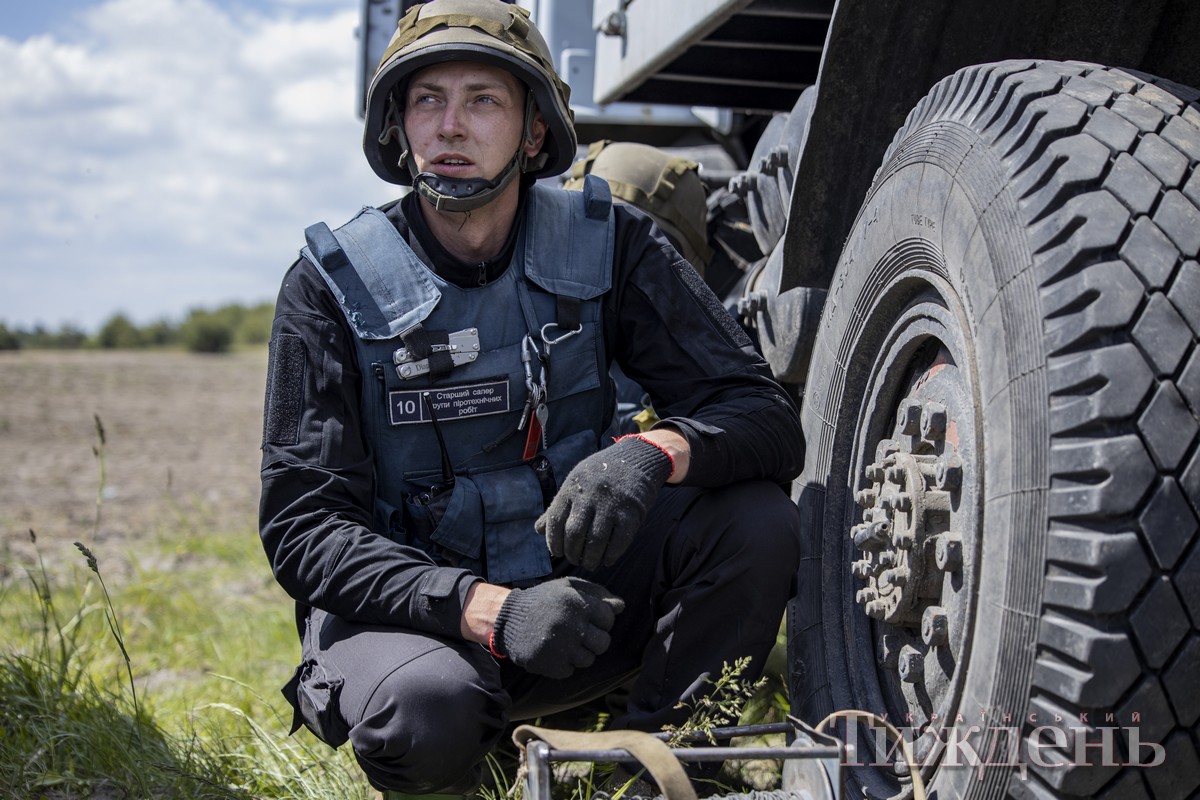
For a second, nothing seems to be happening. One can only hear the buzzing of mosquitoes in the grass. Afterwards, a flash. A loud noise. Soil flies up into the sky, along with sand and metal debris. A black cloud of smoke forms. We listen to the air to hear if there is any whistling. It’s quiet. The sappers talk over the radio. Finally, they give the green light to get up from under the truck. Today they say, was a rather small-scale detonation, the equivalent of only 250kg of TNT.
– We had days when we had to detonate around 6 tons of TNT worth of ammunition. The shockwave from the explosion was so big that our truck was rocked left and right. Some debris even hit it. Overall, I can’t even tell you how much ammunition we’ve destroyed over the past two months. Perhaps, tens, maybe even hundreds of tons, – says Oleksandr.
His colleagues roll up the cables and go to check the detonation point. Around the hole, we can see big pieces of metal, the size of one’s forearm, still extremely hot. The sappers warn everyone – it is best not to leave the roads in the Kyiv region. First of all, one can find similar debris everywhere and injure themselves. Secondly, forests, fields and river banks can be filled with mines.
– Yes, there were discussions cornering the ‘demining of the Kyiv region’. However, one must understand that we’re talking about major connecting roads, power lines, gas pipelines and houses. Everything else is a matter of years or even decades of work. Therefore, talks of fully demining this territory are early, – says Oleksandr.
Even if the Russians never return to the Kyiv region, the locals will be unable to go for a picnic in the forest or go mushroom hunting for a long time. The risk of dying for those who have lived through the occupation is still high. As these are the shells and mines that are unpredictable when it comes to danger. They may be lying around for years, waiting for their moment.
